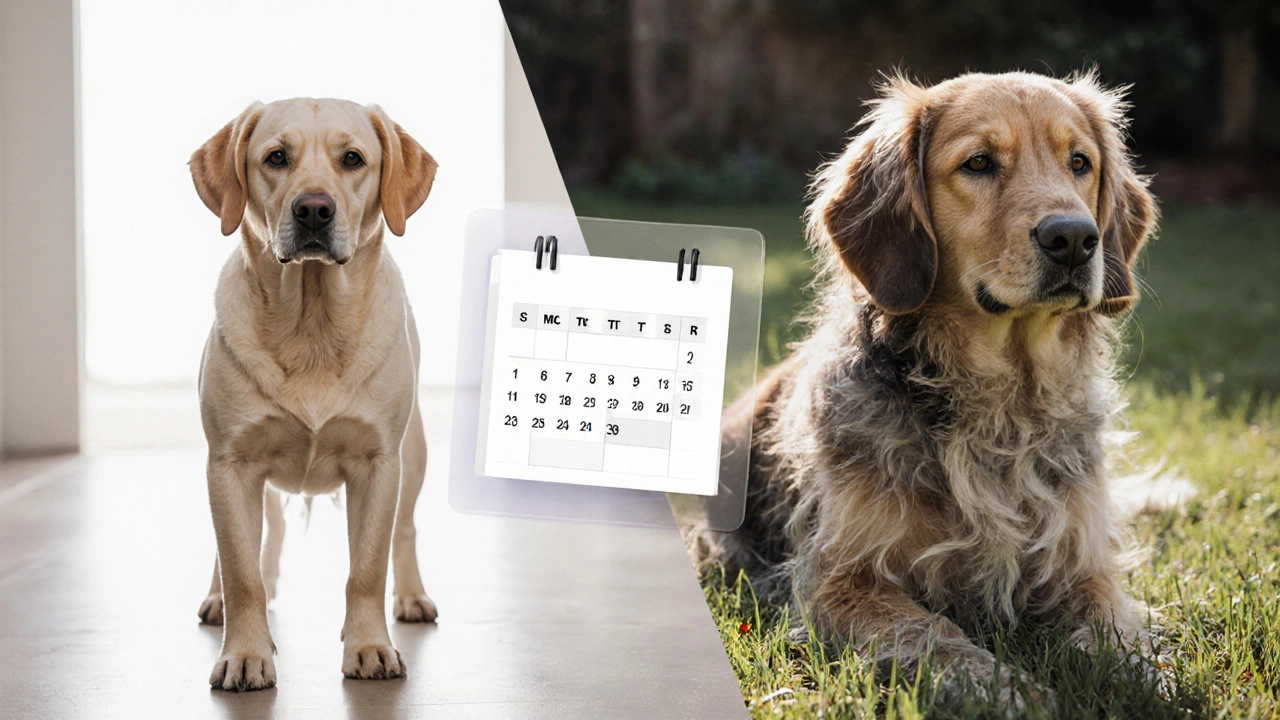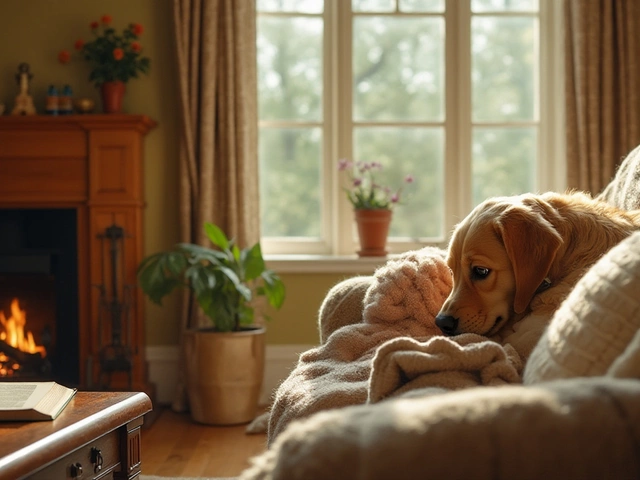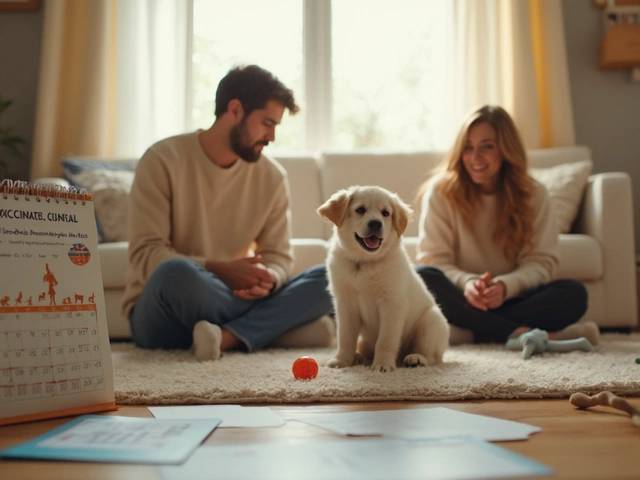Dog Grooming Frequency Calculator
Select your dog's coat type to determine the recommended grooming frequency:
Short, Smooth
Beagle, Boxer
Medium, Wavy
Collie, Border Collie
Long, Silky
Shih Tzu, Lhasa Apso
Double Coat
Golden Retriever, Husky
Curly/Wiry
Poodle, Bichon Frise
Recommended Grooming Frequency
Additional Grooming Tips
- Look for signs like mats, odor, or excessive scratching to know when to groom sooner.
- Consider a mix of professional and at-home grooming sessions for optimal care.
- Don't over-groom double-coated breeds - it can disrupt natural insulation.
- Regular brushing between professional sessions helps maintain coat health.
Ever wonder why some dogs look like they just stepped off a runway while others seem perpetually shaggy? The secret often lies in how regularly they get groomed. Figuring out the right dog grooming frequency can keep your pet comfortable, healthy, and looking their best year after year.
What Drives Grooming Frequency?
There isn’t a one‑size‑fits‑all answer. Several factors shape how often a dog needs a grooming session.
- Coat type is a major driver. A silky, single‑coat Labrador will need far fewer trims than a dense, double‑coated Siberian Husky.
- Breed influences shedding patterns, skin oil production, and how quickly mats form.
- Health conditions such as allergies, hormonal imbalances, or skin infections skin health can demand more frequent clean‑ups.
- Seasonal changes matter. Dogs typically shed more during spring and fall, so seasonal shedding often means an extra brush‑out or bath.
- Living environment - an active outdoor dog picks up more dirt and parasites than a couch‑potato house pet.
Coat‑Based Frequency Guide
Below is a quick reference that pairs common coat categories with a suggested number of grooming visits per year. Think of it as a starting point; you may adjust up or down based on the variables above.
| Coat Type | Typical Grooming Sessions (per year) | Key Tasks per Session |
|---|---|---|
| Short, smooth (e.g., Beagle, Boxer) | 4-6 | Bath, nail trim, ear clean, light brushing |
| Medium, wavy (e.g., Collie, Border Collie) | 6-8 | Bath, deep brush, de‑matt, ear & nail care |
| Long, silky (e.g., Shih Tzu, Lhasa Apso) | 8-12 | Full trim, thorough brushing, teeth cleaning |
| Double coat (e.g., Golden Retriever, Siberian Husky) | 6-10 | Deshedding, bath, nail/ear work; avoid shaving |
| Curly/Wiry (e.g., Poodle, Bichon Frise) | 10-12 | Clip to shape, regular scissoring, dental care |
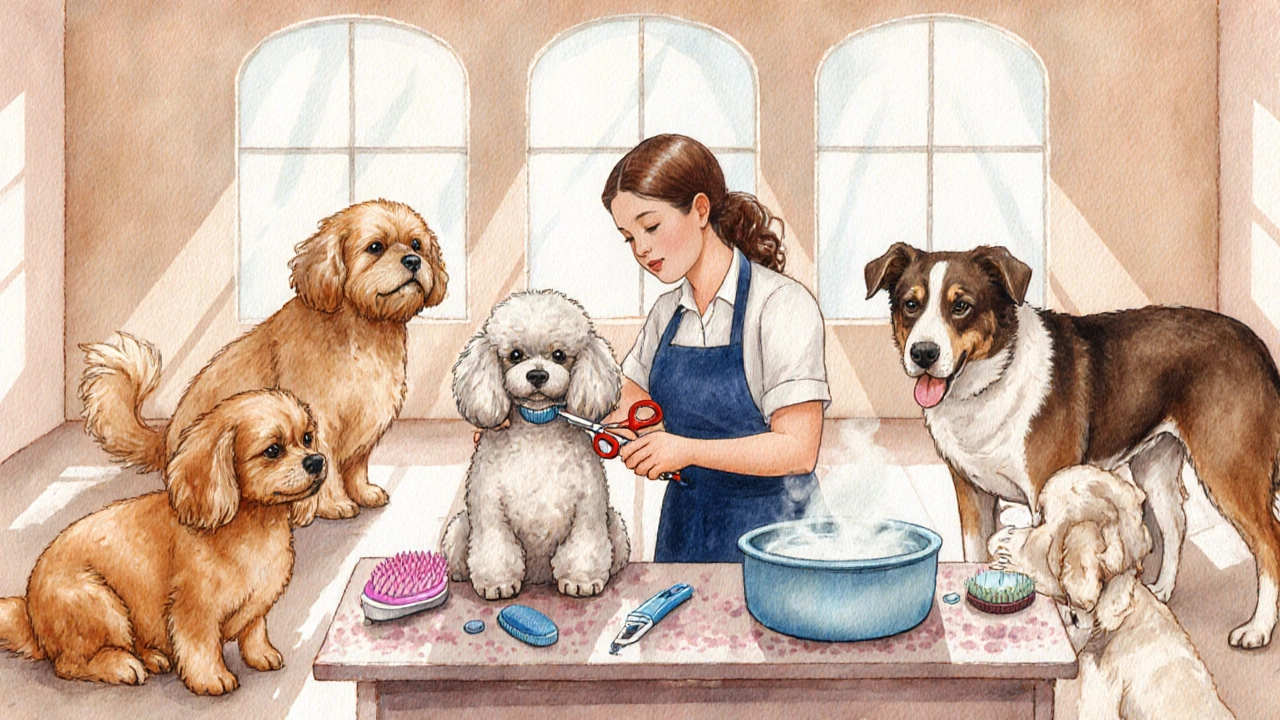
When Your Dog Is Crying Out for a Groom
Even with a solid schedule, real‑life cues tell you it’s time for a trim. Look for these tell‑tale signs:
- Visible mats or tangles that pull on the skin.
- Odor that persists after a quick brush‑out.
- Excessive scratching, licking, or hot spots.
- Coat that looks dull, patchy, or overly greasy.
- Clumps of fur clinging to the paws after a walk.
If any of these pop up, schedule a grooming session ASAP - skipping it can lead to skin irritation or infections.
Professional Groomer vs. At‑Home Grooming
Deciding whether to hand the scissors to a pro or tackle the job yourself hinges on time, budget, and confidence.
Professional groomer brings specialized tools, experience with breed‑specific cuts, and a safe environment for handling anxious dogs. The downside? Each visit can cost $45-$90 depending on size and services.
Doing it at home saves money and can be a bonding ritual, but you’ll need the right grooming tools - a slicker brush, de‑matting comb, quality clippers, and pet‑safe shampoo. Expect a learning curve; a poorly executed trim may lead to uneven hair length or accidental skin nicks.
Here’s a quick pros‑cons checklist:
- Pros of pro grooming: expert styling, quicker turnaround, access to advanced services (e.g., breed‑standard cuts, nail grinding).
- Cons of pro grooming: higher recurring cost, need to book in advance.
- Pros of at‑home grooming: lower long‑term cost, full control over timing, deeper bonding.
- Cons of at‑home grooming: initial tool investment, time commitment, possible learning mishaps.
Building Your Own Grooming Calendar
Turning the frequency guide into a concrete schedule prevents forgotten appointments. Follow these steps:
- Identify your dog’s coat category (see the table above).
- Mark the recommended number of sessions on a yearly calendar - spread them evenly, but add an extra slot for spring/fall shedding.
- Choose a mix of professional and at‑home dates. For example, schedule a pro trim at month3 and a home brush‑out at month6.
- Budget: multiply the estimated cost per professional visit by the number of pro sessions, then add tool depreciation if you’re DIY.
- Set reminders on your phone a week before each appointment - include a checklist of tasks (bath, nail trim, ear clean).
Sample calendar for a medium‑coat Border Collie (8 visits):
- January - Home brush‑out + nail trim
- March - Professional groom (full trim)
- May - Home deep‑brush & ear cleaning
- July - Professional groom (summer cut)
- September - Home de‑matt & dental check
- November - Professional groom (pre‑holiday)
- December - Home quick‑clean before Christmas
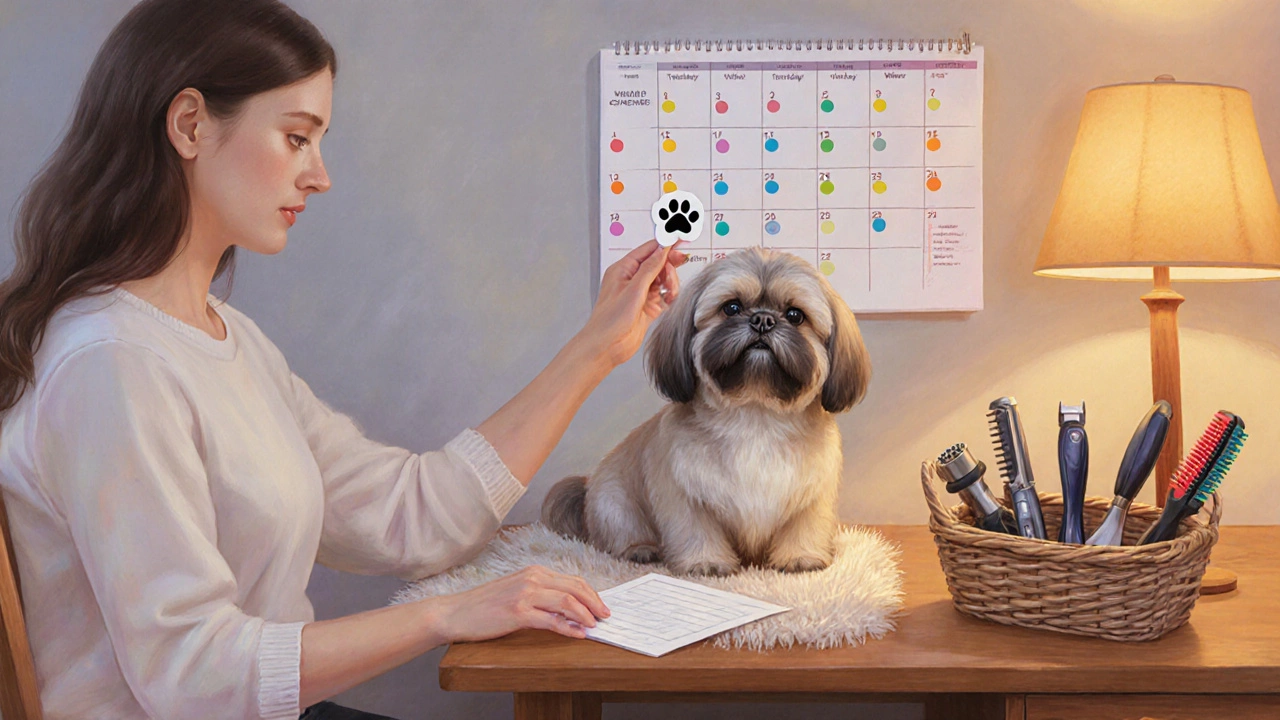
Common Mistakes & How to Avoid Them
Even seasoned owners slip up. Keep these pitfalls in mind:
- Over‑grooming: Shaving a double‑coat breed can disrupt its natural insulation, leading to overheating in summer and cold intolerance in winter.
- Using the wrong brush: Slicker brushes work great on tangled coats but can irritate a short, smooth coat; stick to a rubber brush for those.
- Skipping ear care: Moisture trapped after a bath invites infections, especially in floppy‑ear breeds.
- Neglecting nail length: Over‑grown nails affect gait and can cause joint pain.
When in doubt, consult a vet or professional groomer before making major changes.
Quick Reference Cheat Sheet
- Short coat: 4-6 visits/year
- Medium coat: 6-8 visits/year
- Long coat: 8-12 visits/year
- Double coat: 6-10 visits/year (avoid shaving)
- Curly/wiry: 10-12 visits/year
- Key signs for a grooming session: mats, odor, excessive scratching, dull coat, fur clumps
- Professional vs. DIY: weigh cost, time, skill, and bonding value
Frequently Asked Questions
How often should a puppy be groomed compared to an adult dog?
Puppies usually need fewer full‑body trims but benefit from regular brushing to get them used to handling. Aim for 4-6 light grooming sessions in the first year, then transition to the adult schedule based on coat type.
Can I shower my dog more often than the suggested grooming frequency?
Yes, baths can be more frequent if the dog gets dirty or has skin issues, but they shouldn’t replace a full grooming. Over‑bathing can strip natural oils, leading to dry skin. Stick to a gentle, pet‑safe shampoo and limit baths to once a month unless a vet advises otherwise.
Is it safe to shave a double‑coat breed during summer?
Generally no. Double coats act like natural insulation; shaving removes the protective underlayer and can cause overheating, sunburn, and regrowth problems. Instead, focus on regular de‑shedding, bathing, and a summer‑appropriate trim that leaves enough hair for protection.
What tools do I need for basic at‑home grooming?
A good starter kit includes a slicker brush, a metal comb, pet‑safe clippers with interchangeable blades, a nail grinder or clipper, ear‑clean solution, and a mild dog shampoo. Choose brush types that match your dog’s coat to avoid skin irritation.
How can I tell if my dog’s coat needs a professional trim?
If you’re seeing uneven hair length, stubborn mats, or you’re aiming for a breed‑specific look, it’s time for a pro. Professionals have the right blades and experience to shape curly or wiry coats without causing injury.
